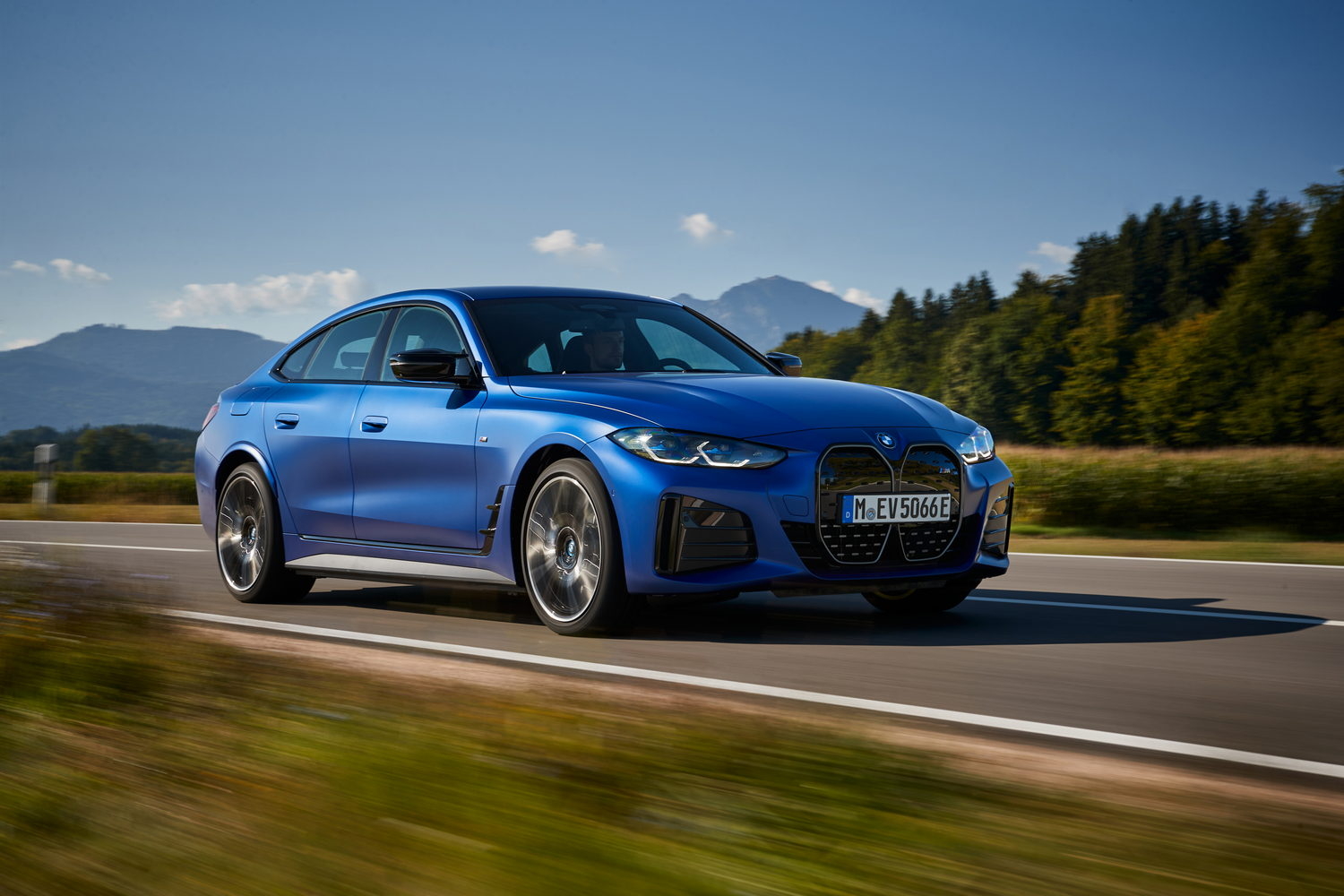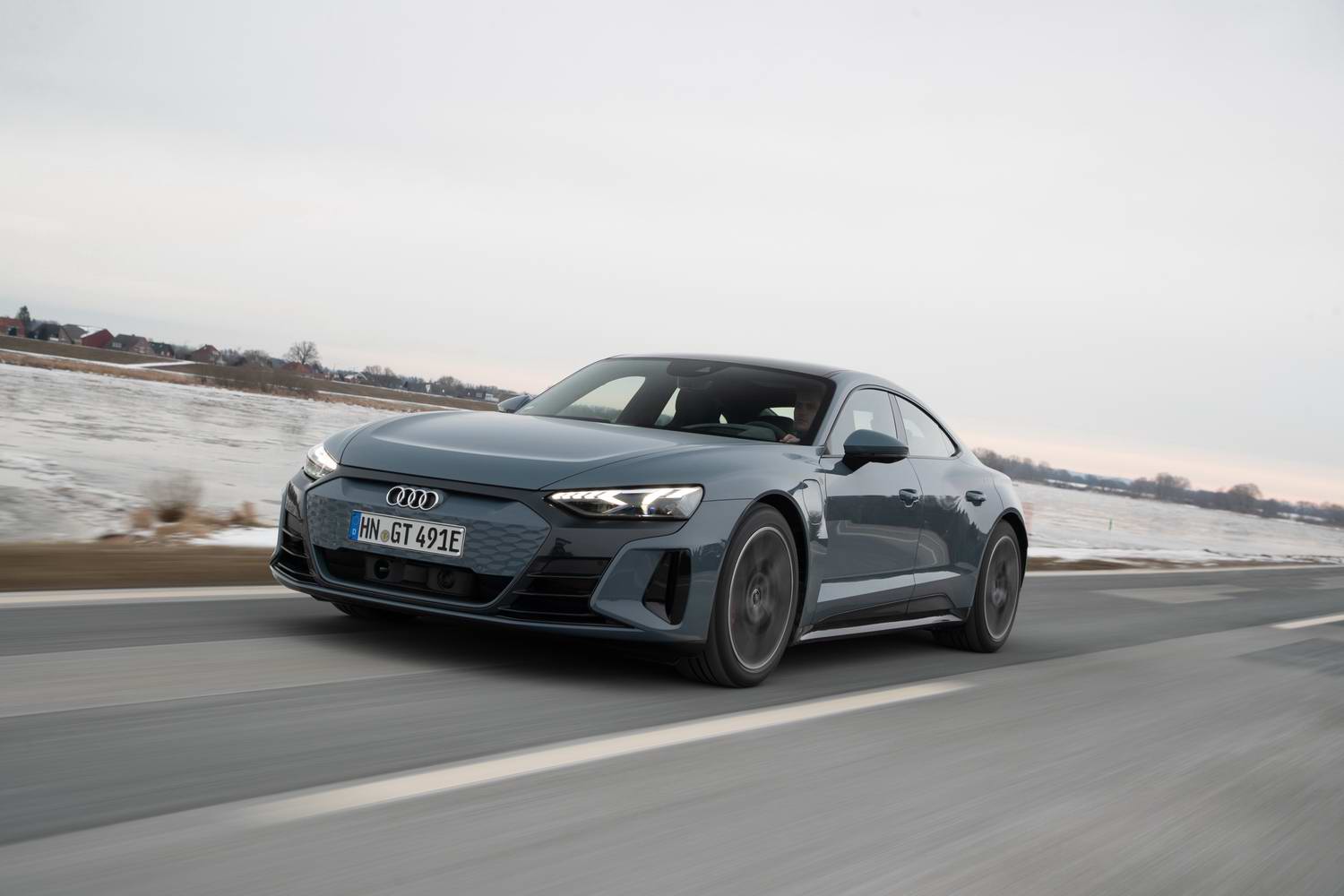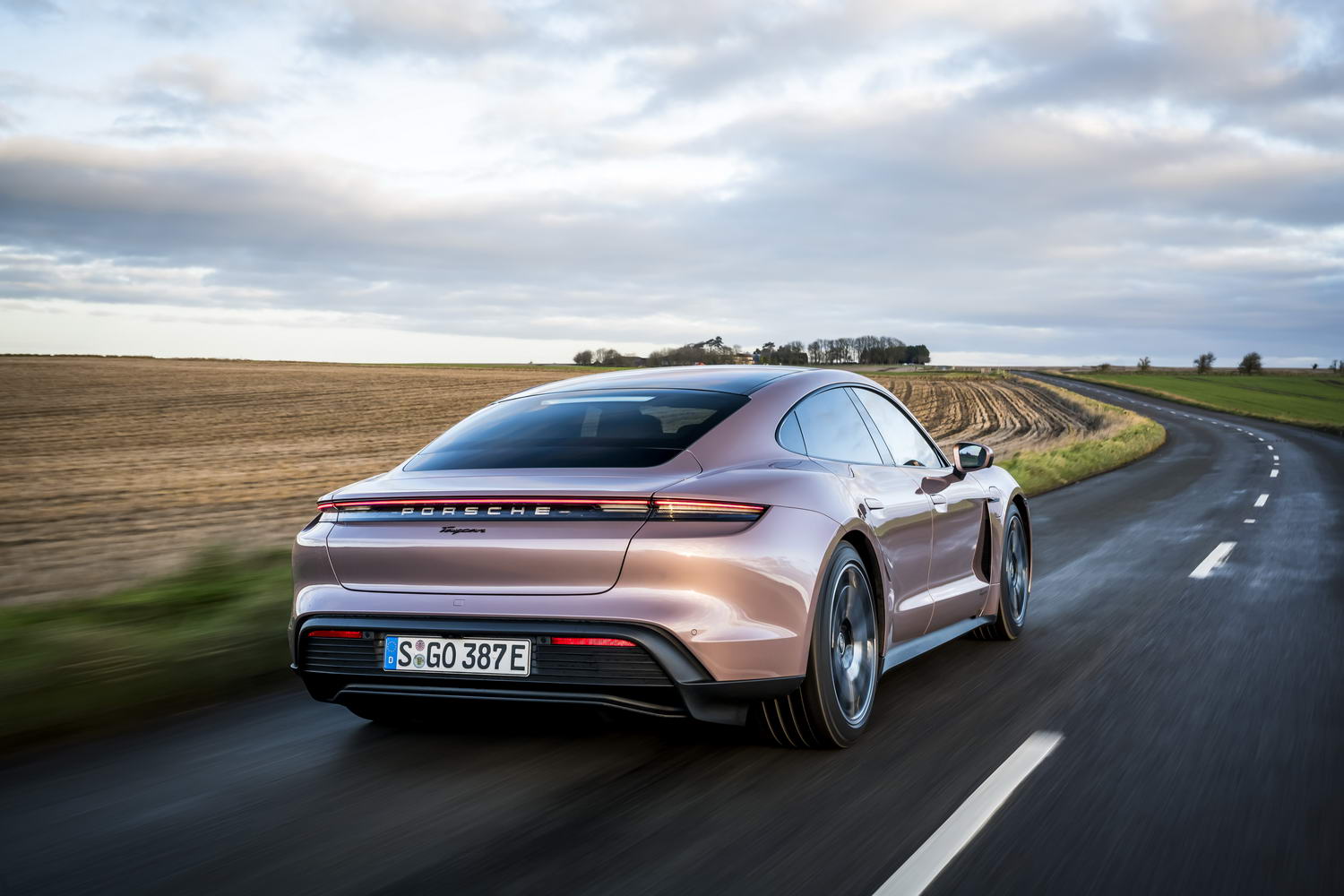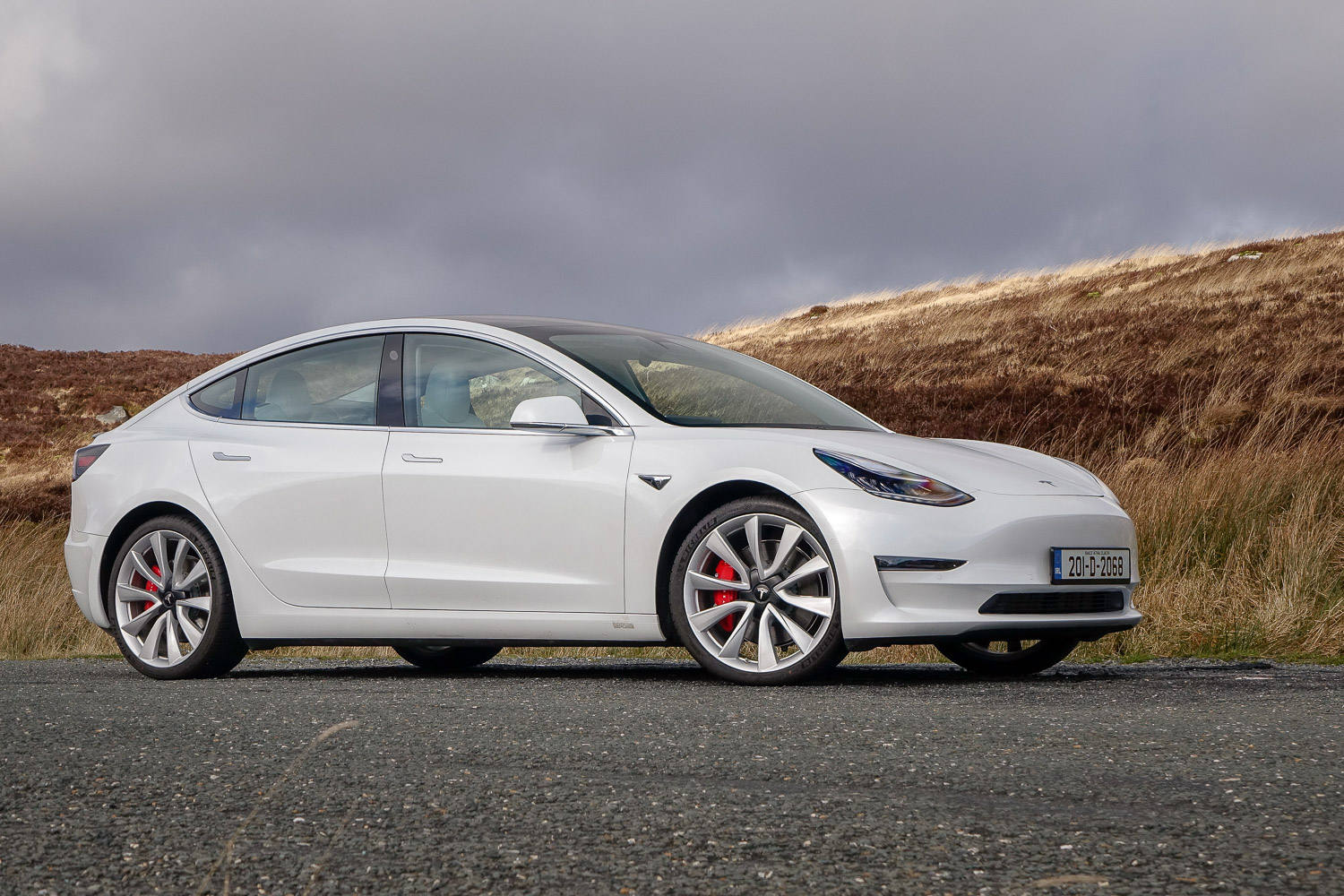As a sign of things to come, the first example of the new BMW 4 Series Gran Coupe we're test-driving is the all-electric i4. Indeed, its development preceded that of the petrol and diesel versions. Will it help traditional BMW buyers make the transition to electric power a seamless one? Our drive in the range-topping i4 M50 model certainly suggests as much.
In the metal
In general, we're not big fans of the upright grille arrangement in the current BMW 4 Series, but it might be growing on us. Either way, we don't find the i4's nose offensive. Indeed, this car in general is quite a stunner. Apparently, the shape of the 4 Series Gran Coupe was designed around the packaging needs of the i4 before it was set in stone, and it really is gorgeous. Admittedly, our favourite view is the rear three quarters, and it's a wheel and colour sensitive design, but in the spec of the test cars at the launch, it's lovely.
Marking out the i4 M50 from its lesser siblings is a more aggressively styled front end, including extra air intakes for brake cooling. The characteristic accent colour of M Performance Vehicles - Cerium Grey - is used in the grille, air curtains, door mirror caps and in the rear bumper. Glossy black trim is applied to the air breathers, side sills and rear bumper.
The M50 gets a unique lip spoiler on the tailgate and, if the optional 20-inch alloy wheels are specified - as pictured - additional body-coloured wheelarch extensions are added to the rear.
The interior of the i4 mixes aspects of the iX with that of the combustion-engined 4 Series, unusually. So, the impressive, curved display and new BMW Operating System 8 are fitted, but a regular round steering wheel is used, and the iDrive controller and cluster of buttons in the centre console are almost unchanged from those of the rest of the line-up.
The curved display includes a 12.3-inch screen for the instruments and a 14.9-inch touchscreen in the middle of the car. Thanks to anti-reflective glass, it looks good even in bright sunshine, and the graphics are crisp. The new menu system focuses on customisation and connectivity, with 5G technology built in. Remote software upgrades and even the option to purchase some functions on demand are included.
Integration with Apple CarPlay and Android Auto is at a high level. For example, the directions from a smartphone's navigation app can be shown within the instrumentation - and even on the head-up display system.
You access the cabin using flush-fitting new handles and all four doors have frameless glass. The door openings for the front seats are smaller than in the 4 Series Coupe, but once inside it feels much the same, with a low-set seat and plenty of driving position adjustment. Visibility isn't bad, either.
The rear door apertures are a little more restrictive, but once you squeeze past them, there's perfectly adequate space in the outer two positions for adults to get comfortable. The middle seat, thanks to the shape of the floor and the seat base, is best kept for occasional use only.
The seat back splits 40:20:40, though, and folds down to create a long load area for when the regular boot - measuring in at 470 litres - isn't big enough. There's an electrically opening and closing tailgate as standard, too.
Driving it
A good starting point for this i4 is its driving position. The design of the steering wheel and sports seat, the visibility and the wide range of adjustability makes it feel like any other BMW with a sporty leaning. Other than the fancy new dashboard, the driving controls are familiar, too.
And while the electric powertrain is whisper quiet as you move away (other than an external noise to warn pedestrians), the movement of the wheels over the road makes the whole car feel like a BMW from the off. It's effortless and easy to drive slowly with perfectly modulated accelerator and brake pedals.
There are no paddles behind the steering wheel to let the driver alter the level of brake energy regeneration, but there is a 'B' mode that can be chosen from the drive selector. This ups the amount of energy recuperated when you lift off the accelerator pedal, causing a higher deceleration force and enabling one-pedal driving at lower speeds.
BMW has also fitted the i4 with its new integrated braking system that separates the pedal feel from the rest of the workings, the intention being consistent pressure under your foot regardless of whether the hydraulic brakes or the electric generators (i.e. the motors operating as generators) are slowing the car. It's highly effective, in that, unlike in many other hybrid and electric cars, you don't feel the transition from regenerative braking to hydraulic through your foot.
Even at low speeds it's clear that the i4's steering is well-weighted and pleasantly responsive. The M50 features a variable ratio system as standard that aids agility and low-speed manoeuvring without sacrificing high-speed stability.
And when you do up the pace in this car, it doesn't take long to smile thanks to the huge performance on tap. There's an electric motor on each axle and how much each is used varies depending on driving mode, how the car is being driven and grip levels. By default, only the rear motor is employed, and that puts out up to 313hp and 365Nm of torque.
However, when the two motors work in unison, there's up to 544hp and a massive 795Nm of torque produced. A built-in launch control system also enables an M4-equalling 0-100km/h time of 3.9 seconds. Away from rest, traction in the dry is nigh-on perfect, while BMW's patented 'near-actuator wheel slip limitation' traction control system should ensure it's fairly seamless in wet conditions, too.
But lots of people make electric cars that are fast in a straight line. A 0-100km/h time that equals that of the BMW M4 is of no use if the i4 couldn't hold its head high in the cornering stakes too.
It's worth reiterating that this i4 M 50 is not a full-on M car, but what BMW calls an M Performance Vehicle. These sit between the regular BMW range and the M models. They are developed by the BMW M division, but to the specifications of its parent company.
Hence, you'll not hear BMW talking about buyers that will bring the i4 M 50 on track. And indeed, it feels first and foremost like a road car. Albeit a very well sorted one. BMW says that the i4 gets specific structure stiffening over and above the 4 Series Gran Coupe, while the M50 model gets extra strut bracing. A stiff structure theoretically allows relatively soft spring rates, without sacrificing control of the wheels and body.
All i4 models get air springs at the back for self-levelling and the xDrive40 comes with dampers that use a mechanical lift-related system of altering the damping force at each wheel. The M50 is fitted adaptive damping as standard.
In the default Comfort driving setting it feels pliant but not soft, controlled, stable and more than pleasant to drive. Response to the accelerator is measured rather than instantaneous, though serious performance is accessible if you push the pedal all the way down.
That takes a giant leap up in Sport Boost mode, where maximum performance is delivered for up to 10 seconds at a time. That may not sound like long, but have you ever held the accelerator pedal down for a full 10 seconds on the public road? In this setting, the suspension is firmer for sure, but it's never bone-jarring, even on the optional 20-inch alloy wheels. Swift direction changes are a doddle.
The car feels a little edgier in this setting, but never M-car edgy. It feels like you're going fast, too, rather than isolating you from the outside world. Saying all that, it is generally very refined.
There's a sound piped into the car that was developed by the famous composer, Hans Zimmer. It isn't very intrusive in the default driving mode, but it's quite loud when you've selected Sport Boost and you're pushing on. The noise is amusing at first, and we like the 'overrun' mimicking when the brake energy regeneration is happening, but it becomes tiresome on a long journey. It's fine for a blast up a tight and twisty road, as there are no gearchanges, so the intensity of the sound keeps resetting as such, but otherwise, we're not so sure.
In terms of efficiency and range, our test drive in Germany was conducted in warm temperatures, but at higher speeds than would be possible in Ireland. We saw an average energy consumption figure of about 23kWh/100km, which suggests a range of over 400km. Even with some motorway driving at Irish speeds, most drivers should surpass that regularly.
What you get for your money
Pricing (pre-Budget 2022) for the i4 is already on the BMW Ireland website and it shows a starting price of €63,560 for the i4 eDrive40 version in Sport guise - or €65,404 upgraded to M Sport. That's the rear-drive version with headline figures including 340hp, 430Nm and up to 589km of range.
Unsurprisingly, that's expected to be the best-selling i4 here.
The i4 M50 costs from €78,310 and both versions are noticeably well-equipped.
For reference, the 4 Series Gran Coupe (only available as an M Sport or M Sport Pro Edition) costs from €57,199 as a 420d, while the 420i Gran Coupe is priced from €57,803. The entry-level i4 is much faster and more powerful than either and undercuts all variants that have similar performance.
Summary
Buyers in the enviable position to be considering one of the higher-performing versions of the new BMW 4 Series Gran Coupe really need to take a test drive in the i4 before they make any decision. This is the car that will convince traditional BMW buyers that electric power is indeed the future, and it's a future not to be feared, but welcomed with open arms.
































